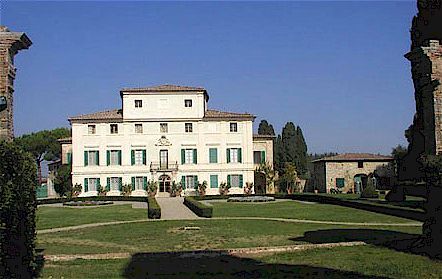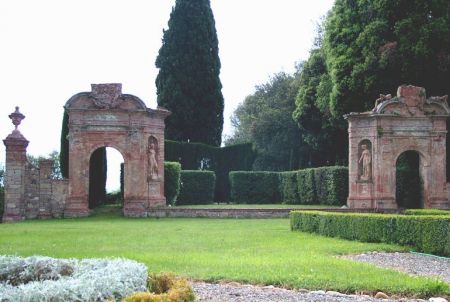Villa di Geggiano and its garden
(Villa Bianchi Bandinelli)

Villa Geggiano
The Villa di Geggiano, owned by the Bianchi Bandinelli family from the first half of the 16 C, was originally a much smaller lodge, which in 1768, was transformed into a grand villa with a garden and its own chapel on the occasion of the wedding of Anton Domenico Bianchi Bandinelli and Cecilia Chigi. A long tree-lined avenue, with cypresses in the first part and holm oaks further on, leads all the way to the entrance gate, parallel to the Teatro di Verzura, the outdoor theatre on the south side of the garden. The rectangular villa spreads over three floors, with a central tower that adds an extra floor to the building. There are two blocks to the sides of the building: the one to the right contains the Madonna of the Rosary family chapel. The side of the building facing the garden, at the centre of which is the doorway surmounted by a balcony, is decorated with flat pilaster strips and string-courses. The garden can be divided into two areas: the one in front of the villa is known as the Piazzone; the other is the kitchen garden. The Piazzone is laid out parallel to the front of the building, with large lawns at the sides edged with low box hedges and ending at the southern end in the 18th-century Teatro di Verzura. This slightly raised theatre is surrounded by tall laurel hedges and consists of a proscenium made up of twin arches, surmounted by triumphal pediments into which the crests of the Bianchi Bandinelli and Chigi Zondadari families are inserted. The arches have niches containing the statues of Tragedy and Comedy, by the Maltese sculptor Bosio. Vittorio Alfieri performed one of his tragedies here in the late 18th century. The entire garden is surrounded by a high wall into which six gates open, flanked by monumental pillars crowned by terracotta vases and statues of monkeys. There are two openings to the south, at the sides of the theatre, two to the west, leading into the kitchen garden, one to the east, leading out to the countryside and one to the north, alongside the villa. The kitchen garden, which occupies a square portion of land to the west, ends in a semi-circular brickwork fishpond and is organised as an Italian-style garden with geometrical beds arranged around a well.


